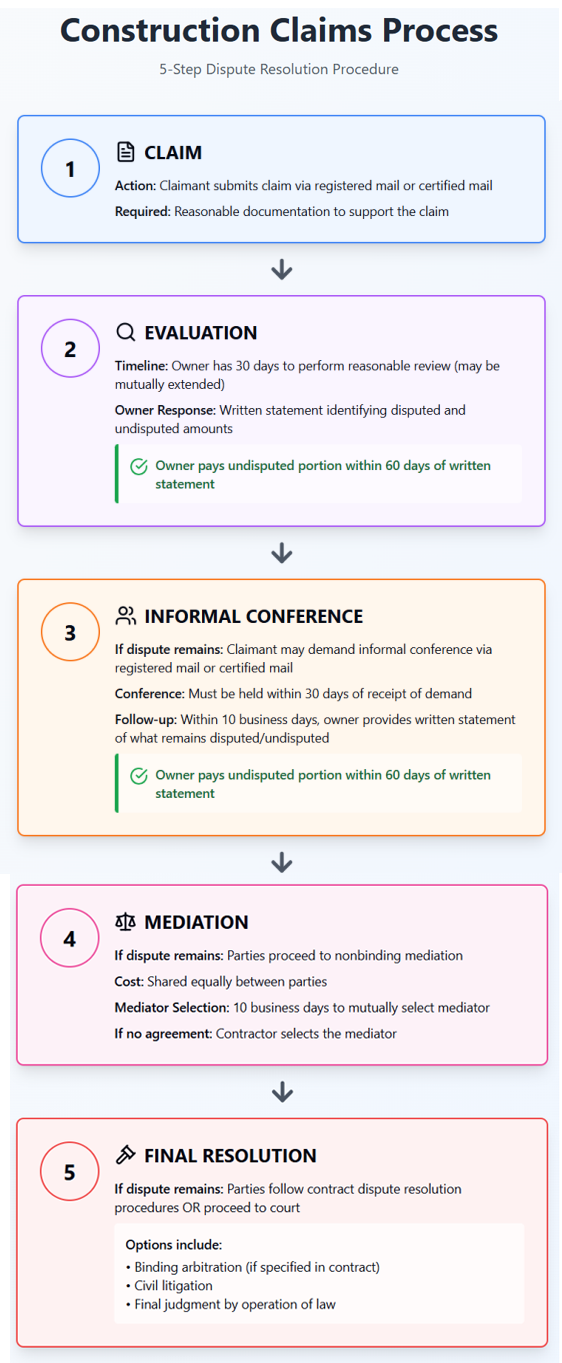California to Implement Retention Cap and Change-Order Dispute Requirements for Private Works in 2026
California to Implement Retention Cap and Change-Order Dispute Requirements for Private Works in 2026
California is implementing two new laws for contracts entered into on or after January 1, 2026, for commercial and large mixed-use projects. Residential and mixed-use projects four stories and under are exempt.
Retention Capped at 5% (SB 61) — Civil Code § 8811
SB 61 adds Section 8811 to the California Civil Code. Under this new law, retention may not exceed 5% of the payment, and total retention withheld may not exceed 5% of the contract price. Also, the retention percentage withheld from a subcontractor may not exceed the percentage in the contract between the owner and direct contractor.
Projects Impacted:
- Private nonresidential projects.
- Private mixed-use residential projects over four stories.
Parties Impacted:
- Owners, general contractors, and subcontractors — all contract tiers.
- Other contracting parties: The new law applies to any “contract relating to a private work of improvement.” This means contracting parties other than those licensed by CSLB are also affected. For example, material suppliers and third-party inspectors who contract on private works must comply.
Key Provisions:
- Retention may not exceed 5% of a progress payment.
- For subcontracts, the retention percentage may not exceed the percentage specified in the contract between the owner and the direct contractor. For example, if the owner’s contract with the direct contractor calls for 3% retention, then the direct contractor’s contract with subcontractors cannot exceed 3% retention.
- Total retention withheld may not exceed 5% of the contract price.
- Exception — Bonds: The cap on retention does not apply if a subcontractor fails to furnish a performance and payment bond requested at bidding.
- Enforcement: A prevailing party in any action to enforce Section 8811 is entitled to recover reasonable attorney fees. In litigation, this may open parties up to attorney fees even if a contract does not contain a prevailing party attorney fees provision.
- Not Waivable — The parties cannot waive Section 8811’s requirements.
Practical Steps:
- Review and update contract templates for compliance.
- Make sure subcontract retention is in line with the retention in the prime contract.
- Evaluate bonding requirements. Requiring subcontractor bonds may preserve flexibility on retention amounts.
- Inform support teams (administrative, in-house counsel, project managers) to ensure compliance.
Private Works Change Order Fair Payment Act (SB 440) — Civil Code § 8850 et seq.
This new law establishes a process to resolve change order and other payment disputes for private works contracts entered into on or after January 1, 2026. The new law will sunset on January 1, 2030, unless extended.
Under the new law, contractors’ claims for time extensions, relief from delay damages, and claims for additional compensation for work must go through the claim resolution process set forth in SB 440 (Civil Code Section 8850 et seq.), unless the parties agree otherwise.
Projects Impacted:
- Private nonresidential projects.
- Private mixed-use residential projects over four stories.
Parties Impacted:
- Owners, general contractors, and subcontractors — all contract tiers.
Key Provisions:
- A contractor’s claim must be made to the owner by registered or certified mail with return receipt requested.
- Once a claim is submitted, the owner must respond within 30 days identifying the disputed and undisputed portions of the claim.
- Payment for the undisputed portions must be made within 60 days of the owner’s written response. If not, interest accrues at 2% per month.
- For disputed portions, the parties proceed through an informal conference, followed by mediation, and then litigation/arbitration. However, the parties may mutually agree to waive the informal conference and mediation and proceed directly to litigation/arbitration.
- A contractor may issue a stop-work notice, and suspend work after 40 days “without penalty,” if the owner fails to comply with timelines.
- Not Waivable — Parties may not waive the requirements of SB 440. However, contracts may include additional “reasonable change order, claim, and dispute resolution procedures,” so long as they do not conflict with or impair the timeframes and procedures established by SB 440.
Subcontractor Claims:
- A contractor is required to present a subcontractor’s claim to the owner.
- A contractor must tell the subcontractor within 30 days whether the claim was presented and, if not, why.
- The subcontractor must approve in writing any settlement of its claim.
Practical Steps:
- Review and update contract templates for compliance.
- Review and update internal dispute resolution procedures and guidelines for compliance.
- Inform support teams (administrative, in-house counsel, project managers) to ensure compliance.
Claims Process Flow Chart:

(Click here for a full-text description of the process.)
For More Information, Please Contact:
Receive legal alerts, case analysis, and event invitations.

